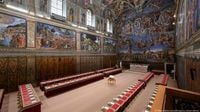In a momentous event for the Roman Catholic Church, 133 cardinals have gathered in the Vatican to begin the conclave aimed at electing a new Pope. The conclave commenced on Wednesday, May 7, 2025, following the passing of Pope Francis on April 21, 2025, at the age of 89 after a prolonged illness. The first day of the conclave is dedicated to various religious and preparatory ceremonies, as the cardinals prepare for the sacred task ahead.
In a bid to maintain secrecy and ensure the sanctity of the election process, mobile communication will be turned off in the area surrounding the Sistine Chapel, where the conclave is taking place. According to Italian television reports, the signal shutdown is set to occur at 15:00 local time, an hour and a half before the cardinals arrive at the chapel. The Italian agency ANSA has also reported that electronic warfare systems will be deployed near the chapel to guarantee that there is no communication with the outside world during the conclave.
Matteo Bruni, a representative of the Holy See, confirmed that the signal shutdown will not affect St. Peter's Square, the central square of the Vatican, ensuring that the public remains informed of developments outside the conclave. As the cardinals prepare to enter the chapel, thousands of onlookers have gathered in anticipation of the symbolic white smoke that will signal the election of a new Pope.
The Sistine Chapel, renowned for its breathtaking frescoes by Michelangelo, has been closed to visitors for several days as it is readied for the conclave. According to tradition, the conclave will take place behind closed doors, completely isolated from the outside world, with the only exception being the delivery of meals.
During the conclave, the cardinals will engage in discussions and debates before conducting a secret vote. Each cardinal will write the name of their chosen candidate on a piece of paper, which will be collected and counted. In order for a candidate to be elected, they must receive two-thirds of the votes plus at least one additional vote. The voting process typically takes place several times a day until a consensus is reached.
Historically, the duration of conclaves has varied significantly. While some conclaves have concluded in as little as two days, others have extended for years. The previous Pope, Francis I, was elected in just two days, a rapid process attributed to the emergence of two dominant candidates. However, the current situation is markedly different, with no clear favorites among the candidates. Gianfranco Ravasi, an Italian cardinal, noted, "The cardinals are very different, so it will be more difficult to agree."
Among the potential candidates for the papacy, Cardinal Pietro Parolin, the 70-year-old Secretary of State of the Holy See, is frequently mentioned as a frontrunner. Parolin, who hails from Northern Italy, is regarded as a favorite in betting circles. Two other Italian candidates, Cardinal Pierbattista Pizzaballa, the Latin Patriarch of Jerusalem, and Cardinal Matteo Maria Zuppi, the Archbishop of Bologna, are also seen as strong contenders, both supporting the reforms initiated by the late Pope Francis.
As the conclave progresses, the anticipation builds among the faithful and onlookers alike. The world will learn of the conclave's outcome through the smoke that rises from the chimney of the Sistine Chapel. Black smoke indicates that no decision has been reached, while white smoke signifies that a new Pope has been elected. The first smoke signal is expected around 20:00 Moscow time.
Despite the excitement surrounding the conclave, the outcome remains uncertain. The cardinals face internal disagreements regarding the future direction of the Church, with some advocating for the continuation of Pope Francis's reforms, while others argue for a change in course. This division reflects a broader shift in the composition of the College of Cardinals, with an increasing number of representatives from South America, Africa, and Asia, as opposed to the historical predominance of European cardinals.
As the conclave unfolds, the cardinals will face the challenge of navigating these complexities while seeking to elect a leader who can unite the Church and address the pressing issues of the day. The eyes of the world remain fixed on the Vatican, where tradition meets the modern challenges of a global faith.
With the conclave commencing, the anticipation for the new Pope's election is palpable. The process, steeped in tradition and solemnity, represents not only a transition in leadership but also a moment of reflection for the Catholic Church as it seeks to chart its course in an ever-changing world.

